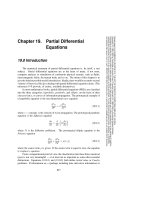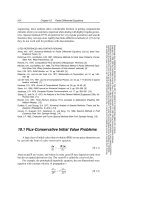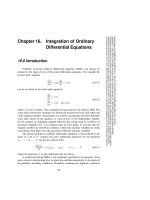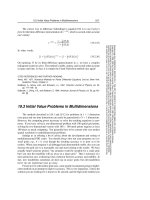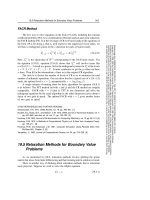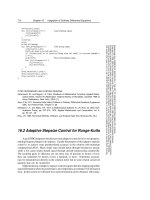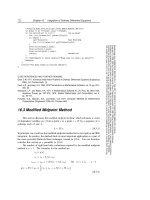elementary differential equations boyce
Bạn đang xem bản rút gọn của tài liệu. Xem và tải ngay bản đầy đủ của tài liệu tại đây (9.98 MB, 1,310 trang )
Elementary
Differential
Equations and
Boundary Value
Problems
SEVENTH EDITION
Elementary Differential
Equations and Boundary
Value Problems
William E. Boyce
Edward P. Hamilton Professor Emeritus
Richard C. DiPrima
formerly Eliza Ricketts Foundation Professor
Department of Mathematical Sciences
Rensselaer Polytechnic Institute
John Wiley & Sons, Inc.
New York Chichester Weinheim Brisbane Toronto Singapore
ASSOCIATE EDITOR Mary Johenk
MARKETING MANAGER Julie Z. Lindstrom
PRODUCTION EDITOR Ken Santor
COVER DESIGN Michael Jung
INTERIOR DESIGN Fearn Cutter DeVicq DeCumptich
ILLUSTRATION COORDINATOR Sigmund Malinowski
This book was set in Times Roman by Eigentype Compositors, and printed and bound by
Von Hoffmann Press, Inc. The cover was printed by Phoenix Color Corporation.
This book is printed on acid-free paper.
∞
᭺
The paper in this book was manufactured by a mill whose forest management programs include sustained
yield harvesting of its timberlands. Sustained yield harvesting principles ensure that the numbers of trees
cut each year does not exceed the amount of new growth.
Copyright
c
2001 John Wiley & Sons, Inc. All rights reserved.
No part of this publication may be reproduced, stored in a retrieval system or transmitted
in any form or by any means, electronic, mechanical, photocopying, recording, scanning
or otherwise, except as permitted under Sections 107 or 108 of the 1976 United States
Copyright Act, without either the prior written permission of the Publisher, or
authorization through payment of the appropriate per-copy fee to the Copyright
Clearance Center, 222 Rosewood Drive, Danvers, MA 01923, (508) 750-8400, fax
(508) 750-4470. Requests to the Publisher for permission should be addressed to the
Permissions Department, John Wiley & Sons, Inc., 605 Third Avenue, New York, NY
10158-0012, (212) 850-6011, fax (212) 850-6008, E-Mail:
Library of Congress Cataloging in Publication Data:
Boyce, William E.
Elementary differential equations and boundary value problems / William E. Boyce,
Richard C. DiPrima – 7th ed.
p. cm.
Includes index.
ISBN 0-471-31999-6 (cloth : alk. paper)
1. Differential equations. 2. Boundary value problems. I. DiPrima, Richard C. II. Title
QA371 .B773 2000
515’.35–dc21 00-023752
Printed in the United States of America
10987654321
To Elsa and Maureen
To Siobhan, James, Richard, Jr., Carolyn, and Ann
And to the next generation:
Charles, Aidan, Stephanie, Veronica, and Deirdre
The Authors
William E. Boyce received his B.A. degree in Mathematics from Rhodes College,
and his M.S. and Ph.D. degrees in Mathematics from Carnegie-Mellon University. He
is a member of the American Mathematical Society, the Mathematical Association
of America, and the Society of Industrial and Applied Mathematics. He is currently
the Edward P. Hamilton Distinguished Professor Emeritus of Science Education
(Department of Mathematical Sciences) at Rensselaer. He is the author of numerous
technical papers in boundary value problems and random differential equations and
their applications. He is the author of several textbooks including two differential
equations texts, and is the coauthor (with M.H. Holmes, J.G. Ecker, and W.L.
Siegmann) of a text on using Maple to explore Calculus. He is also coauthor (with
R.L. Borrelli and C.S. Coleman) of Differential Equations Laboratory Workbook
(Wiley 1992), which received the EDUCOM Best Mathematics Curricular Innovation
Award in 1993. Professor Boyce was a member of the NSF-sponsored CODEE
(Consortium for Ordinary Differential Equations Experiments) that led to the
widely-acclaimed ODE Architect. He has also been active in curriculum innovation
and reform. Among other things, he was the initiator of the “Computers in Calculus”
project at Rensselaer, partially supported by the NSF. In 1991 he received the
William H. Wiley Distinguished Faculty Award given by Rensselaer.
Richard C. DiPrima (deceased) received his B.S., M.S., and Ph.D. degrees in
Mathematics from Carnegie-Mellon University. He joined the faculty of Rensselaer
Polytechnic Institute after holding research positions at MIT, Harvard, and Hughes
Aircraft. He held the Eliza Ricketts Foundation Professorship of Mathematics at
Rensselaer, was a fellow of the American Society of Mechanical Engineers, the
American Academy of Mechanics, and the American Physical Society. He was also
a member of the American Mathematical Society, the Mathematical Association of
America, and the Society of Industrial and Applied Mathematics. He served as the
Chairman of the Department of Mathematical Sciences at Rensselaer, as President of
the Society of Industrial and Applied Mathematics, and as Chairman of the Executive
Committee of the Applied Mechanics Division of ASME. In 1980, he was the recip-
ient of the William H. Wiley Distinguished Faculty Award given by Rensselaer. He
received Fulbright fellowships in 1964–65 and 1983 and a Guggenheim fellowship in
1982–83. He was the author of numerous technical papers in hydrodynamic stability
and lubrication theory and two texts on differential equations and boundary value
problems. Professor DiPrima died on September 10, 1984.
PREFACE
This edition, like its predecessors, is written from the viewpoint of the applied mathe-
matician, whose interest in differential equations may be highly theoretical, intensely
practical, or somewhere in between. We have sought to combine a sound and accurate
(but not abstract) exposition of the elementary theory of differential equations with
considerable material on methods of solution, analysis, and approximation that have
proved useful in a wide variety of applications.
The book is written primarily for undergraduate students of mathematics, science,
or engineering, who typically take a course on differential equations during their first
or second year of study. The main prerequisite for reading the book is a working
knowledge of calculus, gained from a normal two- or three-semester course sequence
or its equivalent.
A Changing Learning Environment
The environment in which instructors teach, and students learn, differential equations
has changed enormously in the past few years and continues to evolve at a rapid pace.
Computing equipment of some kind, whether a graphing calculator, a notebook com-
puter, or a desktop workstation is available to most students of differential equations.
This equipment makes it relatively easy to execute extended numerical calculations,
to generate graphical displays of a very high quality, and, in many cases, to carry out
complexsymbolicmanipulations.Ahigh-speedInternet connection offersanenormous
range of further possibilities.
The fact that so many students now have these capabilities enables instructors, if
they wish, to modify very substantially their presentation of the subject and their
expectations of student performance. Not surprisingly, instructors have widely varying
opinions as to how a course on differential equations should be taught under these
circumstances. Nevertheless, at many colleges and universities courses on differential
equations are becoming more visual, more quantitative, more project-oriented, and less
formula-centered than in the past.
vii
viii Preface
Mathematical Modeling
The main reason for solving many differential equations is to try to learn something
about an underlying physical process that the equation is believed to model. It is basic
to the importance of differential equations that even the simplest equations correspond
to useful physical models, such as exponential growth and decay, spring-mass systems,
or electrical circuits. Gaining an understanding of a complex natural process is usually
accomplished by combining or building upon simpler and more basic models. Thus
a thorough knowledge of these models, the equations that describe them, and their
solutions, is the first and indispensable step toward the solution of more complex and
realistic problems.
More difficult problems often require the use of a variety of tools, both analytical and
numerical. We believe strongly that pencil and paper methods must be combined with
effective use of a computer. Quantitative results and graphs, often produced by a com-
puter, serve to illustrate and clarify conclusions that may be obscured by complicated
analytical expressions. On the other hand, the implementation of an efficient numerical
procedure typically rests on a good deal of preliminary analysis – to determine the
qualitative features of the solution as a guide to computation, to investigate limiting or
special cases, or to discover which ranges of the variables or parameters may require
or merit special attention.
Thus, a student should come to realize that investigating a difficult problem may
well require both analysis and computation; that good judgment may be required to
determine which tool is best-suited for a particular task; and that results can often be
presented in a variety of forms.
A Flexible Approach
To be widely useful a textbook must be adaptable to a variety of instructional strategies.
This implies at least two things. First, instructors should have maximum flexibility to
choose both the particular topics that they wish to cover and also the order in which
they want to cover them. Second, the book should be useful to students having access
to a wide range of technological capability.
With respect to content, we provide this flexibility by making sure that, so far as
possible, individual chapters are independent of each other. Thus, after the basic parts
of the first three chapters are completed (roughly Sections 1.1 through 1.3, 2.1 through
2.5, and 3.1 through 3.6) the selection of additional topics, and the order and depth in
which they are covered, is at the discretion of the instructor. For example, while there is
a good deal of material on applications of various kinds, especially in Chapters 2, 3, 9,
and 10, most of this material appears in separate sections, so that an instructor can easily
choose which applications to include and which to omit. Alternatively, an instructor
who wishes to emphasize a systems approach to differential equations can take up
Chapter 7 (Linear Systems) and perhaps even Chapter 9 (Nonlinear Autonomous
Systems) immediately after Chapter 2. Or, while we present the basic theory of linear
equations first in the context of a single second order equation (Chapter 3), many
instructors have combined this material with the corresponding treatment of higher
order equations (Chapter 4) or of linear systems (Chapter 7). Many other choices and
Preface ix
combinations are also possible and have been used effectively with earlier editions of
this book.
With respect to technology, we note repeatedly in the text that computers are ex-
tremely useful for investigating differential equations and their solutions, and many
of the problems are best approached with computational assistance. Nevertheless, the
book is adaptable to courses having various levels of computer involvement, ranging
from little or none to intensive. The text is independent of any particular hardware
platform or software package. More than 450 problems are marked with the symbol
᭤
to indicate that we consider them to be technologically intensive. These problems may
call for a plot, or for substantial numerical computation, or for extensive symbolic ma-
nipulation, or for some combination of these requirements. Naturally, the designation
of a problem as technologically intensive is a somewhat subjective judgment, and the
᭤ is intended only as a guide. Many of the marked problems can be solved, at least in
part, without computational help, and a computer can be used effectively on many of
the unmarked problems.
From a student’s point of view, the problems that are assigned as homework and
that appear on examinations drive the course. We believe that the most outstanding
feature of this book is the number, and above all the variety and range, of the problems
that it contains. Many problems are entirely straightforward, but many others are more
challenging, and some are fairly open-ended, and can serve as the basis for independent
student projects. There are far more problems than any instructor can use in any given
course, and this provides instructors with a multitude of possible choices in tailoring
their course to meet their own goals and the needs of their students.
One of the choices that an instructor now has to make concerns the role of computing
inthecourse.For instance,manymoreorless routine problems,suchas those requesting
the solution of a first or second order initial value problem, are now easy to solve by
a computer algebra system. This edition includes quite a few such problems, just as
its predecessors did. We do not state in these problems how they should be solved,
because we believe that it is up to each instructor to specify whether their students
should solve such problems by hand, with computer assistance, or perhaps both ways.
Also, there are many problems that call for a graph of the solution. Instructors have
the option of specifying whether they want an accurate computer-generated plot or a
hand-drawn sketch, or perhaps both.
There are also a great many problems, as well as some examples in the text, that
call for conclusions to be drawn about the solution. Sometimes this takes the form of
asking for the value of the independent variable at which the solution has a certain
property. Other problems ask for the effect of variations in a parameter, or for the
determination of a critical value of a parameter at which the solution experiences a
substantial change. Such problems are typical of those that arise in the applications of
differential equations, and, depending on the goals of the course, an instructor has the
option of assigning few or many of these problems.
Supplementary Materials
Three software packages that are widely used in differential equations courses are
Maple, Mathematica,andMatlab. The books Differential Equations with Maple, Dif-
ferential Equations with Mathematica,andDifferential Equations with Matlab by K. R.
x Preface
Coombes, B. R. Hunt, R. L. Lipsman, J. E. Osborn, and G. J. Stuck, all at the University
of Maryland, provide detailed instructions and examples on the use of these software
packages for the investigation and analysis of standard topics in the course.
For the first time, this text is available in an Interactive Edition, featuring an eBook
version of the text linked to the award-winning ODE Architect. The interactive eBook
links live elements in each chapter to ODE Architect’s powerful, yet easy-to-use, nu-
merical differential equations solver and multimedia modules. The eBook provides a
highly interactive environment in which students can construct and explore mathemat-
ical models using differential equations to investigate both real-world and hypothetical
situations. A companion e-workbook that contains additional problems sets, called
Explorations, provides background and opportunities for students to extend the ideas
contained in each module. A stand-alone version of ODE Architect is also available.
There is a Student Solutions Manual, by Charles W. Haines of Rochester Institute
of Technology, that contains detailed solutions to many of the problems in the book. A
complete set of solutions, prepared by Josef Torok of Rochester Institute of Technology,
is available to instructors via the Wiley website at www.wiley.com/college/Boyce.
Important Changes in the Seventh Edition
Readers who are familiar with the preceding edition will notice a number of mod-
ifications, although the general structure remains much the same. The revisions are
designed to make the book more readable by students and more usable in a modern
basic course on differential equations. Some changes have to do with content; for
example, mathematical modeling, the ideas of stability and instability, and numerical
approximations via Euler’s method appear much earlier now than in previous editions.
Other modifications are primarily organizational in nature. Most of the changes include
new examples to illustrate the underlying ideas.
1. The first two sections of Chapter 1 are new and include an immediate introduction
to some problems that lead to differential equations and their solutions. These sections
also give an early glimpse of mathematical modeling, of direction fields, and of the
basic ideas of stability and instability.
2. Chapter 2 now includes a new Section 2.7 on Euler’s method of numerical ap-
proximation. Another change is that most of the material on applications has been
consolidated into a single section. Finally, the separate section on first order homoge-
neous equations has been eliminated and this material has been placed in the problem
set on separable equations instead.
3. Section 4.3 on the method of undetermined coefficients for higher order equations
has been simplified by using examples rather than giving a general discussion of the
method.
4. The discussion of eigenvalues and eigenvectors in Section 7.3 has been shortened
by removing the material relating to diagonalization of matrices and to the possible
shortage of eigenvectors when an eigenvalue is repeated. This material now appears
in later sections of the same chapter where the information is actually used. Sections
7.7 and 7.8 have been modified to give somewhat greater emphasis to fundamental
matrices and somewhat less to problems involving repeated eigenvalues.
Preface xi
5. An example illustrating the instabilities that can be encountered when dealing
with stiff equations has been added to Section 8.5.
6. Section 9.2 has been streamlined by considerably shortening the discussion of au-
tonomous systems in general and including instead two examples in which trajectories
can be found by integrating a single first order equation.
7. There is a new section 10.1 on two-point boundary value problems for ordinary
differential equations. This material can then be called on as the method of separation
of variables is developed for partial differential equations. There are also some new
three-dimensional plots of solutions of the heat conduction equation and of the wave
equation.
As the subject matter of differentialequations continues to grow, as newtechnologies
become commonplace, as old areas of application are expanded, and as new ones
appear on the horizon, the content and viewpoint of courses and their textbooks must
also evolve. This is the spirit we have sought to express in this book.
William E. Boyce
Troy, New York
April, 2000
ACKNOWLEDGMENTS
Itisapleasure to offermy grateful appreciationtothemany peoplewhohavegenerously
assisted in various ways in the creation of this book.
The individuals listed below reviewed the manuscript and provided numerous valu-
able suggestions for its improvement:
Steven M. Baer, Arizona State University
Deborah Brandon, Carnegie Mellon University
Dante DeBlassie, Texas A & M University
Moses Glasner, Pennsylvania State University–University Park
David Gurarie, Case Western Reserve University
Don A. Jones, Arizona State University
Duk Lee, Indiana Wesleyan University
Gary M. Lieberman, Iowa State University
George Majda, Ohio State University
Rafe Mazzeo, Stanford University
Jeff Morgan, Texas A & M University
James Rovnyak, University of Virginia
L.F. Shampine, Southern Methodist University
Stan Stascinsky, Tarrant County College
Robert L. Wheeler, Virginia Tech
I am grateful to my friend of long standing, Charles Haines (Rochester Institute of
Technology). In the process of revising once again the Student Solutions Manual he
checked the solutions to a great many problems and was responsible for numerous
corrections and improvements.
I am indebted to my colleagues and students at Rensselaer whose suggestions and
reactions through the years have done much to sharpen my knowledge of differential
equations as well as my ideas on how to present the subject.
My thanks also go to the editorial and production staff of John Wiley and Sons. They
have always been ready to offer assistance and have displayed the highest standards of
professionalism.
xii
Acknowledgments xiii
Most important, I thank my wife Elsa for many hours spent proofreading and check-
ing details, for raising and discussing questions both mathematical and stylistic, and
above all for her unfailing support and encouragement during the revision process. In
a very real sense this book is a joint product.
William E. Boyce
CONTENTS
Preface vii
Chapter 1 Introduction 1
1.1 Some Basic Mathematical Models; Direction Fields 1
1.2 Solutions of Some Differential Equations 9
1.3 Classification of Differential Equations 17
1.4 Historical Remarks 23
Chapter 2 First Order Differential Equations 29
2.1 Linear Equations with Variable Coefficients 29
2.2 Separable Equations 40
2.3 Modeling with First Order Equations 47
2.4 Differences Between Linear and Nonlinear Equations 64
2.5 Autonomous Equations and Population Dynamics 74
2.6 Exact Equations and Integrating Factors 89
2.7 Numerical Approximations: Euler’s Method 96
2.8 The Existence and Uniqueness Theorem 105
2.9 First Order Difference Equations 115
Chapter 3 Second Order Linear Equations 129
3.1HomogeneousEquationswithConstantCoefficients 129
3.2FundamentalSolutionsofLinearHomogeneousEquations 137
3.3LinearIndependenceandtheWronskian 147
3.4ComplexRootsoftheCharacteristicEquation 153
3.5RepeatedRoots;ReductionofOrder 160
3.6NonhomogeneousEquations;MethodofUndeterminedCoefficients 169
3.7VariationofParameters 179
3.8MechanicalandElectricalVibrations 186
3.9 Forced Vibrations 200
Chapter 4 Higher Order Linear Equations 209
4.1 General Theory of nth Order Linear Equations 209
4.2 Homogeneous Equations with Constant Coeffients 214
xiv
Contents xv
4.3 The Method of Undetermined Coefficients 222
4.4 The Method of Variation of Parameters 226
Chapter 5 Series Solutions of Second Order Linear Equations 231
5.1 Review of Power Series 231
5.2 Series Solutions near an Ordinary Point, Part I 238
5.3 Series Solutions near an Ordinary Point, Part II 249
5.4 Regular Singular Points 255
5.5 Euler Equations 260
5.6 Series Solutions near a Regular Singular Point, Part I 267
5.7 Series Solutions near a Regular Singular Point, Part II 272
5.8 Bessel’s Equation 280
Chapter 6 The Laplace Transform 293
6.1 Definition of the Laplace Transform 293
6.2 Solution of Initial Value Problems 299
6.3 Step Functions 310
6.4 Differential Equations with Discontinuous Forcing Functions 317
6.5 Impulse Functions 324
6.6 The Convolution Integral 330
Chapter 7 Systems of First Order Linear Equations 339
7.1 Introduction 339
7.2 Review of Matrices 348
7.3 Systems of Linear Algebraic Equations; Linear Independence,
Eigenvalues, Eigenvectors 357
7.4 Basic Theory of Systems of First Order Linear Equations 368
7.5 Homogeneous Linear Systems with Constant Coefficients 373
7.6 Complex Eigenvalues 384
7.7 Fundamental Matrices 393
7.8 Repeated Eigenvalues 401
7.9 Nonhomogeneous Linear Systems 411
Chapter 8 Numerical Methods 419
8.1 The Euler or Tangent Line Method 419
8.2 Improvements on the Euler Method 430
xvi Contents
8.3 The Runge–Kutta Method 435
8.4 Multistep Methods 439
8.5 More on Errors; Stability 445
8.6 Systems of First Order Equations 455
Chapter 9 Nonlinear Differential Equations and Stability 459
9.1 The Phase Plane; Linear Systems 459
9.2 Autonomous Systems and Stability 471
9.3 Almost Linear Systems 479
9.4 Competing Species 491
9.5 Predator–Prey Equations 503
9.6 Liapunov’s Second Method 511
9.7 Periodic Solutions and Limit Cycles 521
9.8 Chaos and Strange Attractors; the Lorenz Equations 532
Chapter 10 Partial Differential Equations and Fourier Series 541
10.1 Two-Point Boundary Valve Problems 541
10.2 Fourier Series 547
10.3 The Fourier Convergence Theorem 558
10.4 Even and Odd Functions 564
10.5 Separation of Variables; Heat Conduction in a Rod 573
10.6 Other Heat Conduction Problems 581
10.7 The Wave Equation; Vibrations of an Elastic String 591
10.8 Laplace’s Equation 604
Appendix A. Derivation of the Heat Conduction Equation 614
Appendix B. Derivation of the Wave Equation 617
Chapter 11 Boundary Value Problems and Sturm–Liouville Theory 621
11.1 The Occurrence of Two Point Boundary Value Problems 621
11.2 Sturm–Liouville Boundary Value Problems 629
11.3 Nonhomogeneous Boundary Value Problems 641
11.4 Singular Sturm–Liouville Problems 656
11.5 Further Remarks on the Method of Separation of Variables: A Bessel Series
Expansion 663
11.6 Series of Orthogonal Functions: Mean Convergence 669
Answers to Problems 679
Index 737
CHAPTER
1
Introduction
In this chapter we try in several different ways to give perspective to your study of
differential equations. First, we use two problems to illustrate some of the basic ideas
that we will return to and elaborate upon frequently throughout the remainder of the
book. Later, we indicate several ways of classifying equations, in order to provide
organizational structure for the book. Finally, we outline some of the major figures and
trends in the historical development of the subject. The study of differential equations
has attracted the attention of many of the world’s greatest mathematicians during the
past three centuries. Nevertheless, it remains a dynamic field of inquiry today, with
many interesting open questions.
1.1 Some Basic Mathematical Models; Direction Fields
Before embarking on a serious study of differential equations (for example, by reading
this book or major portions of it) you should have some idea of the possible benefits
to be gained by doing so. For some students the intrinsic interest of the subject itself is
enough motivation, but for most it is the likelihood of important applications to other
fields that makes the undertaking worthwhile.
Many of the principles, or laws, underlying the behavior of the natural world are
statements or relations involving rates at which things happen. When expressed in
mathematical terms the relations are equations and the rates are derivatives. Equations
containing derivatives are differential equations. Therefore, to understand and to
investigate problems involving the motion of fluids, the flow of current in electric
1
ODE
ODE
2 Chapter 1. Introduction
circuits, the dissipation of heat in solid objects, the propagation and detection of
seismic waves, or the increase or decrease of populations, among many others, it is
necessary to know something about differential equations.
A differential equation that describes some physical process is often called a math-
ematical model of the process, and many such models are discussed throughout this
book. In this section we begin with two models leading to equations that are easy
to solve. It is noteworthy that even the simplest differential equations provide useful
models of important physical processes.
EXAMPLE
1
A Falling
Object
Suppose that an object is falling in the atmosphere near sea level. Formulate a differ-
ential equation that describes the motion.
We begin by introducing letters to represent various quantities of possible interest
in this problem. The motion takes place during a certain time interval, so let us use t
to denote time. Also, let us use v to represent the velocity of the falling object. The
velocity will presumably change with time, so we think of v as a function of t;in
other words, t is the independent variable and v is the dependent variable. The choice
of units of measurement is somewhat arbitrary, and there is nothing in the statement
of the problem to suggest appropriate units, so we are free to make any choice that
seems reasonable. To be specific, let us measure time t in seconds and velocity v in
meters/second. Further, we will assume that v is positive in the downward direction,
that is, when the object is falling.
The physical law that governs the motion of objects is Newton’s second law, which
states that the mass of the object times its acceleration is equal to the net force on the
object. In mathematical terms this law is expressed by the equation
F = ma. (1)
In this equation m is the mass of the object, a is its acceleration, and F is the net force
exerted on the object. To keep our units consistent, we will measure m in kilograms, a
in meters/second
2
,andF in newtons. Of course, a is related to v by a = dv/dt,sowe
can rewrite Eq. (1) in the form
F = m(dv/dt). (2)
Next, consider the forces that act on the object as it falls. Gravity exerts a force equal to
the weight of the object, or mg,whereg is the acceleration due to gravity. In the units
we have chosen, g has been determined experimentally to be approximately equal to
9.8 m/sec
2
near the earth’s surface. There is also a force due to air resistance, or drag,
which is more difficult to model. This is not the place for an extended discussion of
the drag force; suffice it to say that it is often assumed that the drag is proportional
to the velocity, and we will make that assumption here. Thus the drag force has the
magnitude γv,whereγ is a constant called the drag coefficient.
In writing an expression for the net force F we need to remember that gravity always
acts in the downward (positive) direction, while drag acts in the upward (negative)
direction, as shown in Figure 1.1.1. Thus
F = mg − γv (3)
1.1 Some Basic Mathematical Models; Direction Fields 3
and Eq. (2) then becomes
m
dv
dt
= mg − γv. (4)
Equation (4) is a mathematical model of an object falling in the atmosphere near sea
level. Note that the model contains the three constants m, g,andγ . The constants m
and γ depend very much on the particular object that is falling, and usually will be
different for different objects. It is common to refer to them as parameters, since they
may take on a range of values during the course of an experiment. On the other hand,
the value of g is the same for all objects.
γ υ
mg
m
FIGURE 1.1.1 Free-body diagram of the forces on a falling object.
To solve Eq. (4) we need to find a function v = v(t) that satisfies the equation. It
is not hard to do this and we will show you how in the next section. For the present,
however, let us see what we can learn about solutions without actually finding any of
them. Our task is simplified slightly if we assign numerical values to m and γ ,butthe
procedure is the same regardless of which values we choose. So, let us suppose that
m = 10 kg and γ = 2 kg/sec. If the units for γ seem peculiar, remember that γvmust
have the units of force, namely, kg-m/sec
2
. Then Eq. (4) can be rewritten as
dv
dt
= 9.8 −
v
5
. (5)
EXAMPLE
2
A Falling
Object
(continued)
Investigate the behavior of solutions of Eq. (5) without actually finding the solutions
in question.
We will proceed by looking at Eq. (5) from a geometrical viewpoint. Suppose that
v has a certain value. Then, by evaluating the right side of Eq. (5), we can find the
corresponding value of dv/dt. For instance, if v = 40, then dv/dt = 1.8. This means
that the slope of a solution v = v(t) has the value 1.8 at any point where v = 40. We
can display this information graphically in the tv-plane by drawing short line segments,
or arrows, with slope 1.8 at several points on the line v = 40. Similarly, if v = 50, then
dv/dt =−0.2, so we draw line segments with slope −0.2 at several points on the line
v = 50. We obtain Figure 1.1.2 by proceeding in the same way with other values of
v. Figure 1.1.2 is an example of what is called a direction field or sometimes a slope
field.
The importance of Figure 1.1.2 is that each line segment is a tangent line to the
graph of a solution of Eq. (5). Thus, even though we have not found any solutions, and
4 Chapter 1. Introduction
24 t6810
48
44
40
52
60
56
υ
FIGURE 1.1.2 A direction field for Eq. (5).
no graphs of solutions appear in the figure, we can nonetheless draw some qualitative
conclusions about the behavior of solutions. For instance, if v is less than a certain
critical value, then all the line segments have positive slopes, and the speed of the
falling object increases as it falls. On the other hand, if v is greater than the critical
value, then the line segments have negative slopes, and the falling object slows down as
it falls. What is this critical value of v that separates objects whose speed is increasing
from those whose speed is decreasing? Referring again to Eq. (5), we ask what value
of v will cause dv/dt to be zero? The answer is v = (5)(9.8) = 49 m/sec.
In fact, the constant function v(t) = 49 is a solution of Eq. (5). To verify this
statement, substitute v(t) = 49 into Eq. (5) and observe that each side of the equation
is zero. Because it does not change with time, the solution v(t) = 49 is called an
equilibrium solution. It is the solution that corresponds to a balance between gravity
and drag. In Figure 1.1.3 we show the equilibrium solution v(t) = 49 superimposed
on the direction field. From this figure we can draw another conclusion, namely, that
all other solutions seem to be converging to the equilibrium solution as t increases.
24 t6810
48
44
40
52
60
56
υ
FIGURE 1.1.3 Direction field and equilibrium solution for Eq. (5).
1.1 Some Basic Mathematical Models; Direction Fields 5
The approach illustrated in Example 2 can be applied equally well to the more
general Eq. (4), where the parameters m and γ are unspecified positive numbers. The
results are essentially identical to those of Example 2. The equilibrium solution of
Eq. (4) is v(t) = mg/γ . Solutions below the equilibrium solution increase with time,
those above it decrease with time, and all other solutions approach the equilibrium
solution as t becomes large.
Direction Fields. Direction fields are valuable tools in studying the solutions of
differential equations of the form
dy
dt
= f (t, y), (6)
where f is a given function of the two variables t and y, sometimes referred to as
the rate function. The equation in Example 2 is somewhat simpler in that in it f is a
function of the dependent variable alone and not of the independent variable. A useful
direction field for equations of the general form (6) can be constructed by evaluating f
at each point of a rectangular grid consisting of at least a few hundred points. Then,
at each point of the grid, a short line segment is drawn whose slope is the value of f
at that point. Thus each line segment is tangent to the graph of the solution passing
through that point. A direction field drawn on a fairly fine grid gives a good picture
of the overall behavior of solutions of a differential equation. The construction of a
direction field is often a useful first step in the investigation of a differential equation.
Two observations are worth particular mention. First, in constructing a direction
field, we do not have to solve Eq. (6), but merely evaluate the given function f (t, y)
many times. Thus direction fields can be readily constructed even for equations that
may be quite difficult to solve. Second, repeated evaluation of a given function is a
task for which a computer is well suited and you should usually use a computer to
draw a direction field. All the direction fields shown in this book, such as the one in
Figure 1.1.2, were computer-generated.
Field Mice and Owls. Now let us look at another quite different example. Consider
a population of field mice who inhabit a certain rural area. In the absence of predators
we assume that the mouse population increases at a rate proportional to the current
population. This assumption is not a well-established physical law (as Newton’s law of
motion is in Example 1), but it is a common initial hypothesis
1
in a study of population
growth. If we denote time by t and the mouse population by p(t), then the assumption
about population growth can be expressed by the equation
dp
dt
= rp, (7)
where the proportionality factor r is called the rate constant or growth rate.Tobe
specific, suppose that time is measured in months and that the rate constant r has the
value 0.5/month. Then each term in Eq. (7) has the units of mice/month.
Now let us add to the problem by supposing that several owls live in the same
neighborhood and that they kill 15 field mice per day. To incorporate this information
1
A somewhat better model of population growth is discussed later in Section 2.5.
6 Chapter 1. Introduction
into the model, we must add another term to the differential equation (7), so that it
becomes
dp
dt
= 0.5p −450. (8)
Observe that the predation term is −450 rather than −15 because time is measured in
months and the monthly predation rate is needed.
EXAMPLE
3
Investigate the solutions of Eq. (8) graphically.
A direction field for Eq. (8) is shown in Figure 1.1.4. For sufficiently large values
of p it can be seen from the figure, or directly from Eq. (8) itself, that dp/dt is positive,
so that solutions increase. On the other hand, for small values of p the opposite is the
case. Again, the critical value of p that separates solutions that increase from those that
decrease is the value of p for which dp/dt is zero. By setting dp/dt equal to zero in
Eq. (8) and then solving for p, we find the equilibrium solution p(t) = 900 for which
the growth term and the predation term in Eq. (8) are exactly balanced. The equilibrium
solution is also shown in Figure 1.1.4.
12 t345
900
850
800
950
1000
p
FIGURE 1.1.4 A direction field for Eq. (8).
Comparing this example with Example 2, we note that in both cases the equilibrium
solution separates increasing from decreasing solutions. However, in Example 2 other
solutions converge to, or are attracted by, the equilibrium solution, while in Example 3
other solutions diverge from, or are repelled by, the equilibrium solution. In both cases
the equilibrium solution is very important in understanding how solutions of the given
differential equation behave.
A more general version of Eq. (8) is
dp
dt
= rp−k, (9)
1.1 Some Basic Mathematical Models; Direction Fields 7
where the growth rate r and the predation rate k are unspecified. Solutions of this more
general equation behave very much like those of Eq. (8). The equilibrium solution of
Eq. (9) is p(t) = k/r. Solutions above the equilibrium solution increase, while those
below it decrease.
You should keep in mind that both of the models discussed in this section have their
limitations. The model (5) of the falling object ceases to be valid as soon as the object
hits the ground, or anything else that stops or slows its fall. The population model
(8) eventually predicts negative numbers of mice (if p < 900) or enormously large
numbers (if p > 900). Both these predictions are unrealistic, so this model becomes
unacceptable after a fairly short time interval.
Constructing Mathematical Models. In applying differential equations to any of the
numerous fields in which they are useful, it is necessary first to formulate the appropri-
ate differential equation that describes, or models, the problem being investigated. In
this section we have looked at two examples of this modeling process, one drawn from
physics and the other from ecology. In constructing future mathematical models your-
self, you should recognize that each problem is different, and that successful modeling
is not a skill that can be reduced to the observance of a set of prescribed rules. Indeed,
constructing a satisfactory model is sometimes the most difficult part of the problem.
Nevertheless, it may be helpful to list some steps that are often part of the process:
1. Identify the independent and dependent variables and assign letters to represent
them. The independent variable is often time.
2. Choose the units of measurement for each variable. In a sense the choice of units
is arbitrary, but some choices may be much more convenient than others. For
example, we chose to measure time in seconds in the falling object problem and
in months in the population problem.
3. Articulate the basic principle that underlies or governs the problem you are inves-
tigating. This may be a widely recognized physical law, such as Newton’s law of
motion, or it may be a more speculative assumption that may be based on your
own experience or observations. In any case, this step is likely not to be a purely
mathematical one, but will require you to be familiar with the field in which the
problem lies.
4. Express the principle or law in step 3 in terms of the variables you chose in
step 1. This may be easier said than done. It may require the introduction of
physical constants or parameters (such as the drag coefficient in Example 1)
and the determination of appropriate values for them. Or it may involve the use
of auxiliary or intermediate variables that must then be related to the primary
variables.
5. Make sure that each term in your equation has the same physical units. If this is
not the case, then your equation is wrong and you should seek to repair it. If the
units agree, then your equation at least is dimensionally consistent, although it
may have other shortcomings that this test does not reveal.
6. In the problems considered here the result of step 4 is a single differential equation,
which constitutes the desired mathematical model. Keep in mind, though, that in
more complex problems the resulting mathematical model may be much more
complicated, perhaps involving a system of several differential equations, for
example.
